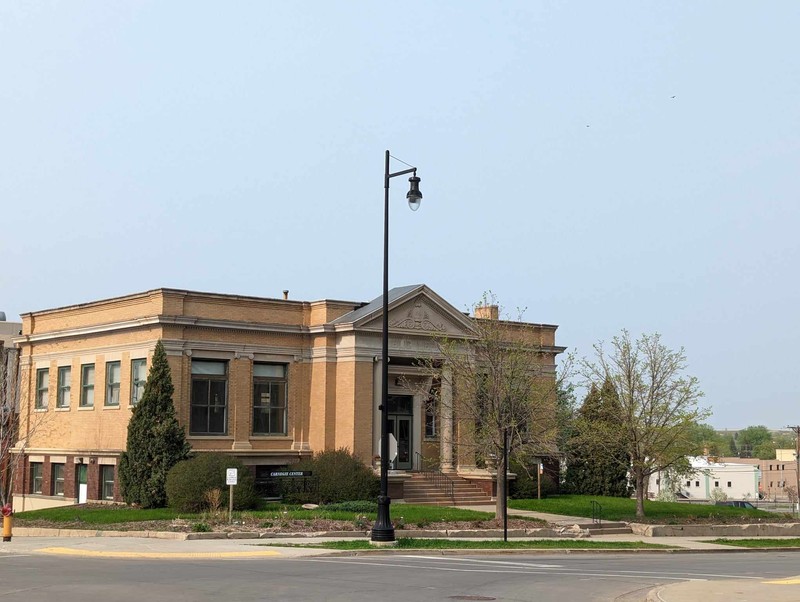Carnegie Library
Introduction
Text-to-speech Audio
This 911 Neo-Classical building was donated by steel magnate Andrew Carnegie. It was one of several public facilities funded by Carnegie in North Dakota. The building represents both the decline of the Gilded Age and the rise of the Progressive Movement in America, the same movement that would produce federal Prohibition. This facility was home to the Minot Public Library until the current location was built on 2nd Avenue, Southwest. The exterior remains unchanged from its construction, and the space is still maintained today as a low-cost event rental to the public.
Images

Carnegie Library, undated.

Backstory and Context
Text-to-speech Audio
By the early years of the twentieth century, the citizens of Minot were aflutter with the idea of petitioning steel magnate, Andrew Carnegie, for funds to build a public library facility. Carnegie was becoming increasingly well known for his donations to public construction projects. In 1906, he donated a library to the University of North Dakota. Carnegie’s conditions stipulated that as long as the town could put up the funds to maintain the building annually, he would provide the capital to construct it. In 1908, Minot voters were enthusiastically in favor of taking on this charge.
In 1911, the building was constructed by the Minot architectural firm Woodruff and McGulpin in the Neo-Classical Revival style. The Carnegie Library served as the public library of Minot until it outgrew the building and was relocated to the current library in 1965. It was one of eleven libraries built with the philanthropist’s funds in North Dakota. By the time the building was added to the National Register of Historic Places in 1980, it was one of only six remaining. Of those six, it is likely the most well conserved in the state.
By the time this building was built, Andrew Carnegie had long been a household name. His wealth was both the envy and the goal of middle-class Americans. But 1911 is right in the middle of what is known in American history as the Progressive Era, where the unbridled power of robber barons and capitalists was being considerably reined in by an increasingly powerful federal government. Prohibition was an attempt by a progressive government to eliminate the alcohol industry, an industry just as rife with corruption, wealth, and predatory interests as that of steel, railroads, or oil.
The construction of a public library building might not seem like the kind of evidence one would look to when searching for signs of the decline of the Gilded Age, but it does represent how progressivism in government inspired an increase in philanthropy. Even if that philanthropy only came to avoid certain tax charges. And while many libraries across the nation carried the name “Carnegie,” none bore the name Adolph Coors, Jack Daniel, or Eberhard Anheuser. Just as much as this facility represents the successes of the Progressive Era, it represents the failures of the Prohibition movement to permanently enforce stringent regulations on alcohol production, distribution, and consumption.
Situated in the heart of Minot’s downtown, the Carnegie Library acts today as an event space. The affordable rental rates are kept that way so as to not limit access to the facility based on socio-economic status.[7] The building is yet another example of how the Prohibition era exerted incredibly influence over the layout of the downtown, and its history provides a lot of the context as to why.
Sources
[1] “Carnegie Gives North Dakota a Library,” The Minot Daily Optic Vol. 11, No. 666, 7 April 1906, accessed 8 July 2023, https://minotlibrary.advantage-preservation.com/viewer/?k=carnegie%20library&i=f&d=01011894-12312009&m=between&ord=k1&fn=the_minot_daily_optic_usa_north_dakota_minot_19060407_english_1&df=1&dt=10&cid=3106.
[2] “Everybody Vote for the Library,” The Minot Daily Reporter Vol. 3, No. 150, 3 April 1908, accessed 8 April 2023, https://minotlibrary.advantage-preservation.com/viewer/?k=carnegie%20library&i=f&d=01011894-12312009&m=between&ord=k1&fn=minot_daily_reporter_usa_north_dakota_minot_19080403_english_1&df=1&dt=10&cid=3106.
[3] “National Register of Historic Places Inventory – Nomination Form,” United States Department of the Interior, Historic Conservation and Recreation Service, 3, 10 September 1980, accessed 8 July 2023, https://npgallery.nps.gov/NRHP/GetAsset/NRHP/80002929_text.
[4] “Carnegie Center,” Minot Area Council of the Arts, 2020, accessed 8 July 2023, https://minotarts.org/carnegie-center/.
